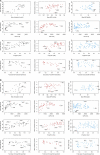Rethinking the "diseases of affluence" paradigm: global patterns of nutritional risks in relation to economic development
- PMID: 15916467
- PMCID: PMC1088287
- DOI: 10.1371/journal.pmed.0020133
Rethinking the "diseases of affluence" paradigm: global patterns of nutritional risks in relation to economic development
Abstract
Background: Cardiovascular diseases and their nutritional risk factors--including overweight and obesity, elevated blood pressure, and cholesterol--are among the leading causes of global mortality and morbidity, and have been predicted to rise with economic development.
Methods and findings: We examined age-standardized mean population levels of body mass index (BMI), systolic blood pressure, and total cholesterol in relation to national income, food share of household expenditure, and urbanization in a cross-country analysis. Data were from a total of over 100 countries and were obtained from systematic reviews of published literature, and from national and international health agencies. BMI and cholesterol increased rapidly in relation to national income, then flattened, and eventually declined. BMI increased most rapidly until an income of about ID 5,000 (international dollars) and peaked at about ID 12,500 for females and ID 17,000 for males. Cholesterol's point of inflection and peak were at higher income levels than those of BMI (about ID 8,000 and ID 18,000, respectively). There was an inverse relationship between BMI/cholesterol and the food share of household expenditure, and a positive relationship with proportion of population in urban areas. Mean population blood pressure was not correlated or only weakly correlated with the economic factors considered, or with cholesterol and BMI.
Conclusions: When considered together with evidence on shifts in income-risk relationships within developed countries, the results indicate that cardiovascular disease risks are expected to systematically shift to low-income and middle-income countries and, together with the persistent burden of infectious diseases, further increase global health inequalities. Preventing obesity should be a priority from early stages of economic development, accompanied by population-level and personal interventions for blood pressure and cholesterol.
Conflict of interest statement
Figures




References
-
- Murray CJL, Lopez AD, editors. The global burden of disease: A comprehensive assessment of mortality and disability from diseases, injuries, and risk factors in 1990 and projected to 2020. Cambridge (Massachusetts): Harvard School of Public Health; 1996. 990 pp.
-
- Reddy KS, Yusuf S. Emerging epidemic of cardiovascular disease in developing countries. Circulation. 1998;97:596–601. - PubMed
-
- Yusuf S, Reddy S, Ounpuu S, Anand S. Global burden of cardiovascular diseases: Part I: General considerations, the epidemiological transition, risk factors, and impact of urbanization. Circulation. 2001;104:2746–2753. - PubMed
-
- Bulatao RA. Mortality by cause, 1970 to 2015. In: Gribble JN, Preston SH, editors. The epidemiological transition: Policy and planning implications for developing countries. Washington (D.C.): National Academy Press; 1993. pp. 42–68. - PubMed
-
- McKeown T. The origins of human disease. Oxford: Blackwell; 1988. 233 pp.
Publication types
MeSH terms
Grants and funding
LinkOut - more resources
Full Text Sources

